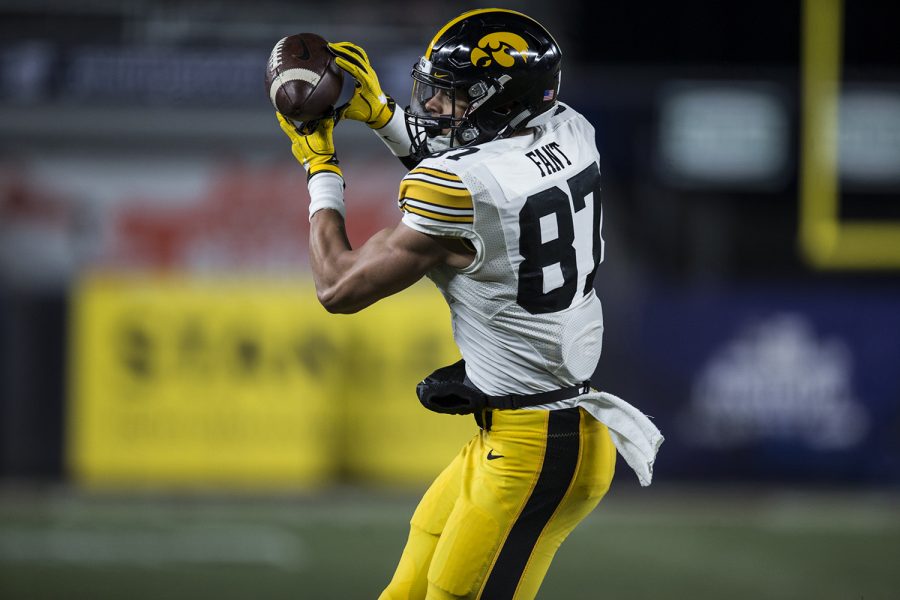Hawkeye football learning from New England Patriots
The Hawkeye coaching staff made a trip to visit the New England Patriots this offseason in an effort to re-energize the team.
Iowa tight end Noah Fant (87) catches a touchdown pass during the New Era Pinstripe Bowl at Yankee Stadium in New York on Wednesday, Dec. 27. The Hawkeyes went on to win 27-20.
August 20, 2018
Newsflash: The New England Patriots are a very good football team from top to bottom.
The Iowa coaching staff knows this, and that’s why some of the Hawkeye coaches traveled to the Patriots’ facility in an effort to get some new insight.
If there’s one thing Iowa and New England have in common, it’s using tight ends.
“There was a period there where [New England] had two tight ends who were extremely dynamic, and we think we have a good tight-end combo,” Kirk Ferentz said at Big Ten media days. “[There are] some things we can borrow or steal from their system.” The Patriots’ tight-end duo in 2011 (when Hawkeye offensive coordinator Brian Ferentz was the Patriots’ tight-end coach) was virtually unstopable. Rob Gronkowski and Aaron Hernandez combined for 169 receptions, 2,237 yards, and 24 touchdowns.
Noah Fant stood out as Iowa’s best target in the passing game last season, and while he didn’t put up Gronk-esque numbers, he did lead the country in touchdowns by a tight end, catching 11. He also boasted a 16.5 yards-per-catch average.
Tight-end counterpart T.J. Hockenson had 320 yards and 3 touchdowns, and the Fant/Hockenson combo scored the most touchdowns by a tight-end duo in the Kirk Ferentz era at Iowa.
“We pull a lot of tension off of each other, and help out the other,” Fant said. “It’s cool how it’s kind of like a ying-yang kind of thing.”
The key to breaking open the offense, especially when featuring tight ends, is tempo, Brian Ferentz said.
“[The Patriots] don’t always play with tempo, but they have the ability to play with tempo,” he said. “I think what that does, you look at the NFL, and it is a very matchup-driven league, and it’s a personnel-driven league. If you watch a National Football League game, for every offensive personnel group that comes into the game, a defensive personnel group comes into the game to match that. College is moving that way.”
He cited Central Florida as a team that is ahead of the game when it comes to tempo. The Knights, then led by current Nebraska head coach Scott Frost, finished 13-0 and paced the nation with 48.2 points per game in 2017.
“The only way tempo works is that you vary the tempo. If you go fast all the time, you’re easy to defend. If you go slow all the time, you’re easy to defend,” Ferentz said. “The teams that do nice job with tempo — I think about Central Florida last year. There’s a team that really took advantage of tempo to create mismatches, more in the old Oregon model.”
But what Central Florida, as well as other teams that focus on tempo, do is more than just playing fast, Ferentz said. It’s all about generating a personnel advantage. If an offense runs at a certain tempo, it locks the defense in with the player package it has on the field.
Fant is a prime example of how Ferentz and Company were able to lock defenses into certain personnel groups. Despite being listed as a tight end, Fant is too fast for most linebackers to cover and too big for most defensive backs. If the Hawkeye offense catches an opposing defense with a linebacker-heavy package, it can open the passing game using Fant.
“We’ve had the ability in the past to play with a little bit of tempo — that’s not always something we’ve hung our hat on; it’s certainly been in our playbook,” Ferentz said. “If the need arises this year, I would hope in Year 2 we’re a little bit further along.”



